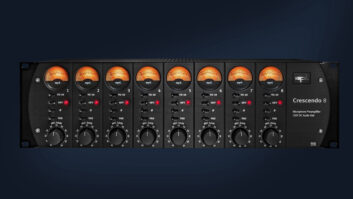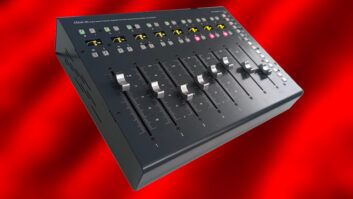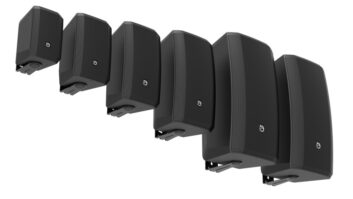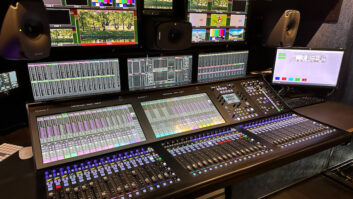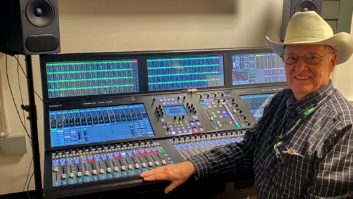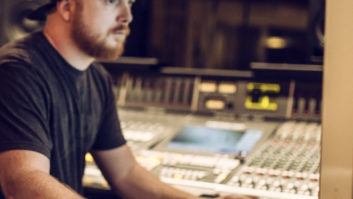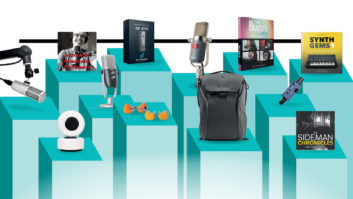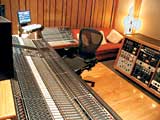

In the world of marketing, high-end pro equipment and budget recording gear have one thing in common: They both use a relatively simple sales pitch. On the superexpensive side of the console market, the product thrust is straightforward: “Behold the best. You’ll pay dearly for this superior quality, but we know that professionals such as yourselves are good for the cash.” On the flip side, the message is equally simple, yet contrary: “Isn’t it amazing how many features are packed into this incredibly small product for this incredibly low, low price?”
But somewhere between the megabuck beasts and the mixers sold in Everytown’s mass-market stores lies an impressive selection of mid-priced products designed for the working pro studio’s day-to-day needs.
Examining the mid-priced console market in 2004, we’ve noticed the availability of some excellent consoles — ones that are arguably high end — for a wonderful price. Here, we define “mid-priced” as consoles in the $50,000 to $150,000 range. Within it are some incredible performers, from complete, all-in-one digital recording solutions to classic-style analog desks with superior electronics. Read on for a collection of consoles that offer high-end quality without the high-end price tag.
The Amek (www.amek.com) Media 51 multiformat analog console features Rupert Neve — designed mic preamps, 4-band channel EQ with fully parametric mids, swept high- and low-frequency with peak-shelf switching, and swept high- and lowpass filters. Eight aux sends, a stereo solo system and soft mutes on both signal paths within each channel are also standard. The console has mixing capability for 5.1, monitoring capability for 7.1 and monitoring for up to four external stem mixes.
Media 51 features Amek’s universal Supertrue™ fader, switch and event automation as standard, allowing intuitive and flexible setting control. The included Supertrue Version 4.0 automation encompasses Amek’s proprietary virtual dynamics, recall, visual FX, synchronization to SMPTE and software control of external components. Available in 32, 48 and 64-channel frame sizes, the Media 51 is priced at $49,950, $69,950 and $89,950, respectively.
Jarvis Studios in New York City boasts a 16-bus, 64-channel (all-input) analog API Legacy with 64 550 equalizers and Flying Faders automation.
API (www.apiaudio.com) is no stranger to high performance with its emphasis on no-compromise analog circuits. Although the company’s Legacy consoles are priced from $100k, a more realistic starting figure hovers around $125k. For example, a 32-channel Legacy with API’s classic 550 Series 4-band EQs, 16 212L all-discrete mic preamps and patchbay lists at about $130,000. The console can be configured with its channels in a split or all-input design. Other basic features include 16 main buses, two stereo buses, six aux sends (five mono/one stereo) and a totally modular design that allows buyers to easily add preamp modules as needs grow. The Legacy also offers frames of up to 64 channels and a choice of the standard long-throw P&G faders or optional moving fader packages from Uptown (900 or 1200 Series) or Flying Faders.
The Audient (www.audient.com) ASP8024 — conceived, designed and created by Audient founders David Dearden and Gareth Davies — is an analog, full-featured in-line desk with 24 track-assign buses and 14 aux buses. Each channel of the ASP8024 features a 4-band splitable equalizer that can be switched into the channel’s short signal path. The center section offers comprehensive metering, monitoring and foldback capabilities with main monitor outputs. Additionally, the center panel offers three alternative speaker outputs and a built-in stereo bus compressor. Available in 24 to 60-channel configurations, the modularly constructed ASP8024 starts at $50,000.
Wilmington, Del. — based Geoff Daking & Co. (www.daking.com) has been making high-performance analog gear for 10 years. The company offers an 8-bus console on a semi-custom basis (each is built to individual client specs), with most priced in the $33k to $99k range. The mixers feature an all-discrete, Class-A transformer-coupled topology; Jensen audio transformers throughout; 4-band EQ with HP/LP filters and five selectable center frequencies per band; four aux sends (pre/post-switchable); auto-mute group muting; stereo in-place solo or destructive solo with solo safe; and direct outs on every channel.

This Digidesign ICON digital console/worksurface is installed at the company’s headquarters south of San Francisco.
Unveiled at April’s NAB convention in Las Vegas, Digidesign‘s (www.digidesign.com) ICON is a fully digital integrated console and complete audio production environment centered on the new D-Control™ tactile worksurface. Using Pro Tools|HD Accel as its core DSP engine and modular Pro Tools|HD audio interfaces for analog and digital I/O, ICON transforms an elaborate DAW controller into a full-blown digital console.
ICON’s D-Control worksurface has built-in 7.1-channel panning, touch-sensitive controls, full processing and routing control per channel, and an expandable architecture with room for extra fader banks. Integrated remote mic preamps are included, and optional Avid picture support increases ICON’s appeal for post users. Each channel strip of the D-Control includes six rotary knobs with LED rings, a six-character scribble strip, mode switches, status LEDs and a P&G fader. ICON comes with XMON, a rackmountable analog monitor system controlled via D-Control. XMON provides access to two 8-channel monitor mixes, three speaker feeds, three stereo cue outputs, a studio monitor feed and a headphone output.
As an adjunct to an existing Pro Tools|HD Accel system, the base ICON configuration adds another $59,995 to the package and includes a 16-fader D-Control module, stand and the XMON monitor interface. Currently, ICON’s maximum configuration is 80 faders; additional 16-fader modules are $29,995 each.

Engineer Mark Zeboski at the Fairlight DREAM Constellation digital console in Studio A at Chicago’s Audio Recording Unlimited (ARU)
Fairlight‘s (www.fairlightau.com) DREAM Constellation large-format digital audio console offers a high-end recording, mixing, automation, plug-in and editing solution for a relatively low price point. Replacing Fairlight’s DREAM console, the TEC Award — nominated Constellation is powered by Fairlight’s QDC engine and incorporates the company’s Binnacle editing model. The Constellation’s ability to edit automation and audio simultaneously allows clips, tracks, ranges or complete projects with previously written automation moves to be carried forward with the audio.
Constellation supports up to 144 channels, 48 buses and 32 mono multitrack buses. Each channel features 6-band equalization and filtering, while two-stage dynamics processing is available on up to 96 of the desk’s inputs, plus 48 returns with 2-band EQ. Accommodating up to four QDC cards, the powerful Constellation is 7.1 surround — ready and offers a flexible monitoring bus system. The DREAM Constellation system starts at $111,000.
Chicago-based Sytek Audio Systems (www.sytek-audio-systems.com) has two very capable analog consoles fitting the mid-priced criteria: the Neotek Elan II and Neotek Elite II. While both consoles feature the same impressive Neotek microphone preamp and high-quality circuit design, the less-expensive Elan II foregoes some of Elite II’s more complex and less-used functions to keep costs down.
The Elite II — Neotek’s flagship console — features dual-channel signal architecture that is neither a split nor an in-line monitoring I/O module approach. Instead, each input module contains two distinct audio paths that are independently operational. Each channel of the Elite II features a sweepable, frequency-style 4-band equalizer and filter, and the console offers additional perks such as a second stereo bus, solid-state muting circuits, flexible automation options and an optional multiformat monitor, which provides a full feature set for monitoring in LCRS or 5.1 environments.
The Elan II features an in-line monitoring design, although many aspects of the Elite II are present within its smaller sibling, including 4-band EQ and the optional multiformat monitor. A 48-channel Elan II is priced at $52,000, and the Elite II ranges in price from $65,846 for the 32-input model to $149,982 for the 96-input model.
John Oram, owner of both Oram Pro Audio and Trident Audio (www.oram.co.uk), offers a trio of high-quality, mid-priced analog consoles: the Trident Audio Series 80 5.1, the Oram Series 24 and the Oram BEQ Pro24 5.1.
The first new console from Trident Audio, the Series 80 5.1 console is a classically designed desk and features a reproduction of the mic pre and 4-band EQ from the original Trident Series 80, which includes two swept mids and switchable high- and low-shelving mids. While the Series 80 5.1 maintains a retro analog sound, it’s ready for modern productions via full 5.1 capabilities. The center section includes the John Oram Hi-Def EQ and dual circuit compression unit.
The Oram BEQ Series 24 and Pro24 5.1 consoles are 24-bus production desks and feature identical microphone preamps and channel EQs. While the Series 24 is suited for stereo-only recording facilities, the surround-ready Pro24 5.1 offers increased performance and includes eight group faders, eight aux sends, eight auxes via small fader routing, 5.1 routing with a sub-output mix matrix, eight stereo returns with EQ and a stereo hi-def EQ Sonicomp compressor. The Pro 24 5.1 also offers a sub-bass output with a built-in crossover. The Trident Series 80 5.1 starts at $63,000, and the BEQ Series 24 and Pro24 5.1 are priced as low as $45,000 and $63,000, respectively.

Slated to start deliveries last month, this SSL AWS 900 DAW worksurface/analog console resides at its demo room near Oxford, England.
To make a big understatement, Solid State Logic (www.solid-state-logic.com) is not a manufacturer regularly associated with mid-priced recording consoles. However, recognizing the potential sales possibilities within this price range, SSL recently unveiled the AWS 900 Analog Workstation System, which employs a full-featured SuperAnalogue signal path with a DAW controller. Guitar Center’s GC Pro stores will handle sales, service and support for the AWS 900.
Resembling a miniature SSL 9k, the 24-channel AWS 900 features switchable SSL E or G Series 4-band parametric EQ; assignable SSL dynamics with gate, expander and compressor/limiter; a G Series stereo main-mix bus compressor; and metering on all channels and main outputs. The desk can also function as a stand-alone 8-bus desk. The AWS 900’s DAW controller system offers a color TFT display to view DAW plug-in settings and status information, along with intuitive DAW control and motion-control panels. The controller provides direct access to all major DAW mixing, editing and automation parameters and has a dedicated control CPU. There’s only one configuration for the AWS 900 and only one price: $85,000. An optional console stand is available.
The Soundtracs (www.digiconsoles.com) DS-00 digital console is an infinitely flexible and wholly expandable desk, suited for use in a variety of settings including broadcast, music recording, live sound, film and post-production. The DS-00 comes standard with 64 channels of full processing, 40 buses and 7.1 surround mixing capability. It also includes eight analog inputs, 16 analog outputs, 24 AES I/O with sample rate conversion for each XLR connection and eight I/O optical connections.
Each DS-00 channel offers eight equalizers, including six fully parametric bands, high- and lowpass filters in the sidechains, dynamics processing and access to all 40 buses. A total of four EX-00 8-fader expansion units can be added to the DS-00, making it possible to build up to a 49-fader surface. Each EX-00 offers a TFT touchscreen and full metering. Designed to be part of a complete recording, mixing and editing system, the DS-00 has a dedicated MADI I/O to connect to DiGiTRAC’s show recorder or another hard disk unit. The DS-00 main fader surface is priced at $68,072, and EX-00 expander units are $14,433 each.
British manufacturer TL Audio (www.tlaudio.co.uk) offers the Valve Technology Console (VTC), an original desk featuring innovative tube (or “valve,” if you’re speaking the Queen’s English) technology throughout. The fully modular, in-line multitrack mixer uses TL Audio’s acclaimed tube circuitry within its channel, monitor, group and master section signal paths. The tubes aren’t just a perfunctory addition to the desk; they are crucial parts of the VTC’s signal path. For instance, every channel and Mix B preamp includes an ECC83/12AX7A tube stage, as well as the Group, Mix B and stereo master mix amplifiers. While recording to tape through a group, a VTC user will bring signal through two tube stages and two additional stages on mixdown for a total of four valve stages in the signal path.
The tubes are positioned within the meter bridge section of the desk and all tube heat travels up and out through the vents in the bridge. As a result, the VTC’s electronics and control surface stay cool.
Distributed in North America by HHB Canada, the TL Audio VTC is available in configurations up to 56 channels with an optional bar graph meter bridge. A fully loaded 56-channel VTC desk sells for $57,000; its optional meter bridge is priced at $4,700.
Strother Bullins is a North Carolina—based freelance writer specializing in the professional audio and entertainment industries.

• Read David Ogilvy’s review of the Audient ASP8024 here.
• For more on the Digidesign ICON, click
here.
• Mix reviews SSL AWS900. Click
here.
• Read Barry Rudolph’s TL Audio VTC review
here.
